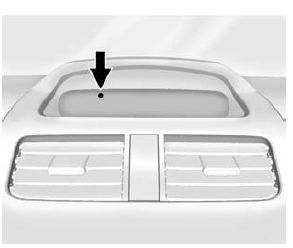Chevrolet Spark Owners Manual: Vehicle Alarm System
This vehicle has an anti-theft alarm system.

The security light, on the instrument panel near the windshield, indicates the status of the system: Off: Alarm system is disarmed.
On Solid: Vehicle is secured during the delay to arm the system.
Fast Flash: Vehicle is unsecured.
A door, the hood, or the trunk is open.
Slow Flash: Alarm system is armed.
Arming the Alarm System
- Turn off the vehicle.
- Lock the vehicle with one of the following:
- Use the RKE transmitter.
- With a door open, press
 on
on
the interior.
- After 30 seconds the alarm system will arm, and the indicator light will
begin to slowly flash indicating the alarm system is operating. Pressing
 on the RKE transmitter a second
on the RKE transmitter a second
time will bypass the 30-second delay and immediately arm the alarm system.
The vehicle alarm system will not arm if the doors are locked with the key.
If the driver door or liftgate is opened without first unlocking with the RKE
transmitter, the horn will chirp and the lights will flash to indicate a pre-alarm.
If the vehicle is not started, or the door is not unlocked by pressing
 on the RKE transmitter during the 10-second
on the RKE transmitter during the 10-second
pre-alarm, the alarm will be activated.
The alarm will also be activated if the passenger door, the liftgate, or the hood is opened without first disarming the system. When the alarm is activated, the turn signals flash and the horn sounds for about 30 seconds. The alarm system will then re-arm to monitor for the next unauthorized event.
Disarming the System
To disarm the system or turn off the alarm if it has been activated, do one of the following:
- Press
 on the RKE transmitter.
on the RKE transmitter. - Start the vehicle.
To avoid setting off the alarm by accident:
- Lock the vehicle with the RKE transmitter after all occupants have left the vehicle and all doors are closed.
- Always unlock the vehicle with the RKE transmitter. Unlocking the driver
door with the key will not disarm the alarm.
Unlocking the driver door with the key will not disarm the system or turn off the alarm.
How to Detect a Tamper Condition
If  is pressed on the RKE transmitter
is pressed on the RKE transmitter
and the horn chirps or the lights flash three times, a previous alarm occurred while
the system was armed.
If the alarm has been activated, a message will appear on the DIC.
See Vehicle Messages on page 5-26 for more information.
Immobilizer
See Radio Frequency Statement on page 13-12.
 Vehicle Security
Vehicle Security
This vehicle has theft-deterrent features; however, they do not make the vehicle
impossible to steal. ...
 Immobilizer Operation
Immobilizer Operation
This vehicle has a passive theft-deterrent system.
The system does not have to be manually armed or disarmed.
The vehicle is automatically immobilized when the key is removed from the ignition.
The ...
Other materials:
Traction Off Light
This light comes on briefly while
starting the engine. If it does not, have the vehicle serviced by your dealer. If
the system is working normally, the indicator light then turns off.
The traction off light comes on when the Traction Control System (TCS) has been
turned off by pressing and re ...
Fuses and Circuit Breakers
The wiring circuits in the vehicle are protected from short circuits by a combination
of fuses, circuit breakers, and fusible thermal links.
This greatly reduces the chance of fires caused by electrical problems.
Look at the silver-colored band inside the fuse. If the band is broken or melted,
...
Engine Overheating
The vehicle has an indicator to warn of the engine overheating. See Engine Coolant
Temperature Warning Light on page 5-18.
If the decision is made not to lift the hood when this warning appears, get service
help right away. See Roadside Assistance Program on page 13-5.
If the decision is made ...
